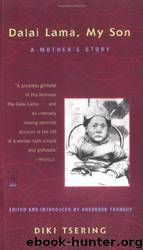Dalai Lama, My Son: A Mother's Story by Diki Tsering

Author:Diki Tsering
Language: eng
Format: azw3
ISBN: 9780140196269
Publisher: Penguin Books
Published: 2001-04-02T00:00:00+00:00
Part II
. . . . . . . . . . . . . . . .
MOTHER of
COMPASSION
16
The Long Journey
We left for Lhasa on the third day of the sixth month in 1939. The date and time for our departure had been set by the astrologers in Lhasa. My mother had come to Kumbum to see us off, but because she was old, she came no farther. She begged me to return to Tsongkha after a year or two. If I had known that it would be many years before I was to see our home again, my sorrow at leaving would have been all the greater.
[NOTE: Some accounts have recorded the date of departure as July 21, 1939.]
Our contingent included me, my husband, Lhamo Dhondup, my sons Gyalo Thondup and Lobsang Samten, and my husband’s elder brother, Ngawang Changchup, the senior steward of Kumbum. My eldest son, Taktser Rinpoche, stayed behind at the monastery, as did my daughter. We left them with the hope that if the situation in Lhasa was amenable, we would send for them.
It was supposed to be a secret that my son had been selected as the fourteenth Dalai Lama, but word soon spread, and many villagers met our caravan, seeking an audience. But while we were still in Chinese territory, no audiences were permitted, because it was too dangerous. We told people that this child was only one of the candidates for Dalai Lama. Two days out of Kumbum we arrived at Tulku monastery, outside Chinese territory. In the shrine room there, a long-life offering ceremony was conducted, after which local people came for audiences.
Along the way some Sangsang tribesmen came and greeted us. To me, coming from Tsongkha, they seemed very dirty, and I criticized them for this. His Holiness became furious that I was judging people by their physical appearance. He was four years old.
From Tulku we went on to Tsaidam, where we spent ten days. Two to three hundred people came to see His Holiness every day. From here we went to Koko Nor, where we pitched tents for three days. It was barren, dry terrain, with no mountains, not even any birds. At some places the grass was so bad that if the horses were to eat it, they would become ill and die. In these places we draped the horses’ mouths with cloth to prevent them from grazing. We saw many wild animals on the journey—asses, mountain goats, and bears. At night the wild asses caused panic among the horses, which scattered. What a headache this caused the horsemen, who had to recover the horses. When wild asses were spotted, guns were immediately fired in the air, to ward them off.
The journey from Kumbum to Lhasa lasted almost three months. [NOTE: The party arrived in Lhasa on October 8, 1939.] There were more than a thousand people in our retinue, and thousands of animals. It was no easy matter to travel day in and day out for months at a stretch.
Download
This site does not store any files on its server. We only index and link to content provided by other sites. Please contact the content providers to delete copyright contents if any and email us, we'll remove relevant links or contents immediately.
The Way of Zen by Alan W. Watts(6505)
Ego Is the Enemy by Ryan Holiday(5294)
The Art of Happiness by The Dalai Lama(4063)
The Book of Joy by Dalai Lama(3899)
Why Buddhism is True by Robert Wright(3404)
Spark Joy by Marie Kondo(3249)
Shift into Freedom by Loch Kelly(3134)
Happiness by Matthieu Ricard(2990)
A Monk's Guide to a Clean House and Mind by Shoukei Matsumoto(2867)
The Lost Art of Good Conversation by Sakyong Mipham(2576)
The Meaning of the Library by unknow(2505)
The Unfettered Mind: Writings from a Zen Master to a Master Swordsman by Takuan Soho(2249)
The Third Eye by T. Lobsang Rampa(2225)
Anthology by T J(2161)
Red Shambhala by Andrei Znamenski(2148)
The Diamond Cutter by Geshe Michael Roach(2018)
Thoughts Without A Thinker: Psychotherapy from a Buddhist Perspective by Epstein Mark(1961)
Twilight of Idols and Anti-Christ by Friedrich Nietzsche(1848)
Advice Not Given by Mark Epstein(1839)
